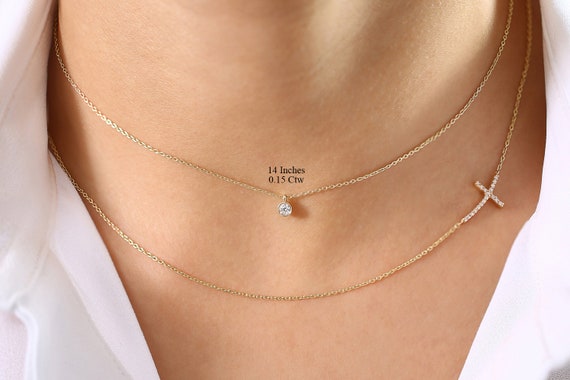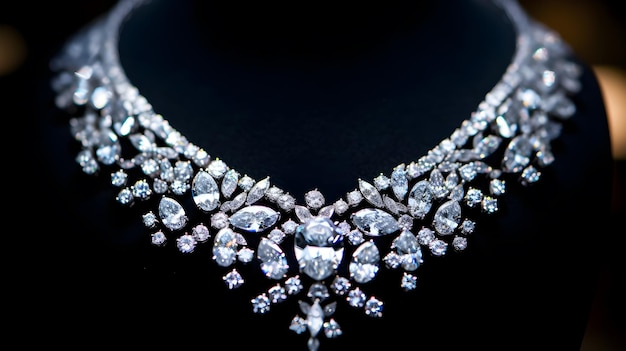When it comes to expressing timeless elegance, nothing compares to a diamond necklace. A diamond necklace is more than just a piece of jewelry—it’s a symbol of luxury, love, sophistication, and personal achievement. Whether you are purchasing a diamond necklace for a loved one or adding to your own collection, this guide will walk you through everything you need to know to make an informed and confident decision in 2025.
Table of Contents
- Introduction to Diamond Necklaces
- History and Symbolism
- Types of Diamond Necklaces
- Diamond Quality: The 4Cs Explained
- How to Choose the Right Diamond Necklace
- Lab-Grown vs Natural Diamonds
- Popular Styles in 2025
- Where to Buy Diamond Necklaces
- Online vs In-store Buying
- Certification and Authenticity
- Budgeting and Pricing Factors
- Care and Maintenance
- Ethical and Sustainable Buying
- Buying Tips for Special Occasions
- Conclusion
Introduction to Diamond Necklaces
Diamond necklaces are beloved for their brilliance, versatility, and emotional significance. From everyday elegance to red-carpet glamour, these necklaces come in countless designs and styles. Their ability to elevate any outfit makes them a staple in both classic and modern jewelry collections.
History and Symbolism
Diamonds have symbolized strength, love, and invincibility for centuries. Ancient civilizations believed diamonds were fragments of fallen stars. Necklaces have long adorned the necks of royalty and icons, often indicating status, commitment, or celebration. Today, a diamond necklace continues to be a meaningful gift for anniversaries, birthdays, weddings, and other milestones.
Types of Diamond Necklaces
Choosing the right type is crucial, as each style offers a different aesthetic and statement:
- Solitaire Pendant: A single diamond on a delicate chain. Timeless and minimalist.
- Tennis Necklace: Features a line of matched diamonds. Elegant and luxurious.
- Station Necklace: Diamonds are spaced evenly along the chain.
- Choker: Sits tightly around the neck, often bold and modern.
- Lariat: A longer, dangling design, sometimes adjustable.
- Bib Necklace: Covers more surface area with a cluster of diamonds. Perfect for statements.
Diamond Quality: The 4Cs Explained
Understanding the 4Cs helps you evaluate diamond value:
- Cut: The most important factor. Influences brilliance.
- Color: Ranges from D (colorless) to Z (light yellow).
- Clarity: Measures internal flaws (inclusions) and external flaws (blemishes).
- Carat Weight: Refers to the diamond’s weight and size.
In a necklace, cut and color often have the biggest visual impact.
How to Choose the Right Diamond Necklace
When buying a diamond necklace, consider:
- Personal Style: Classic, modern, vintage, etc.
- Occasion: Daily wear or special events.
- Face Shape: Some necklace lengths complement certain face shapes.
- Skin Tone: White gold, yellow gold, and rose gold affect the diamond’s appearance.
- Matching Jewelry: Think about coordination with earrings or rings.
Lab-Grown vs Natural Diamonds
Lab-grown diamonds have become increasingly popular:
- Lab-Grown Diamonds: Identical to natural diamonds but made in a lab. More affordable and eco-friendly.
- Natural Diamonds: Mined from the Earth. Often seen as more prestigious.
Both options can be certified and set in high-quality necklaces.
Popular Styles in 2025
Current trends in diamond necklaces include:
- Layered Necklaces: Multiple lengths worn together.
- Custom Initials and Names: Personalized pendants with diamonds.
- Color Accent Diamonds: Blue, pink, or yellow diamonds used artistically.
- Vintage-Inspired Cuts: Asscher, emerald, and cushion cuts.
- Convertible Necklaces: Can transform from choker to pendant.
Where to Buy Diamond Necklaces
Top places to purchase a diamond necklace include:
- Luxury Retailers: Tiffany & Co., Cartier, Harry Winston.
- Online Jewelers: Blue Nile, James Allen, Brilliant Earth.
- Department Stores: Nordstrom, Bloomingdale’s, Neiman Marcus.
- Independent Jewelers: Offer customization and unique pieces.
- International Markets: Dubai, Antwerp, and Mumbai are global diamond hubs.
Online vs In-store Buying
Online Buying:
- Greater selection and competitive pricing.
- Virtual try-ons and 360-degree views.
- Convenient and private.
In-store Buying:
- Hands-on experience.
- Professional guidance.
- Immediate sizing and adjustments.
Choose based on comfort level and the value of the purchase.
Certification and Authenticity
Always ask for certifications from reputable labs:
- GIA (Gemological Institute of America)
- AGS (American Gem Society)
- IGI (International Gemological Institute)
These certificates verify the quality and authenticity of the diamond.
Budgeting and Pricing Factors
Pricing depends on:
- Carat weight
- Diamond quality
- Metal type (gold, platinum)
- Brand prestige
- Designer exclusivity
Set a budget and prioritize features like cut and color. Consider financing options if available.
Care and Maintenance
To keep your necklace looking radiant:
- Clean regularly with a soft brush and mild soap.
- Store separately to avoid scratches.
- Use ultrasonic cleaners with caution.
- Visit a jeweler annually for inspections.
Proper care ensures your diamond maintains its sparkle for generations.
Ethical and Sustainable Buying
Ethical practices are crucial in 2025:
- Choose conflict-free diamonds.
- Look for brands with transparent supply chains.
- Support lab-grown options and recycled metals.
- Consider secondhand or vintage for sustainability.
Buying Tips for Special Occasions
- Anniversary: A tennis necklace symbolizes enduring love.
- Wedding Gift: A solitaire pendant complements a bridal set.
- Graduation: A dainty diamond station necklace marks achievement.
- Birthday: Personalized pendants with birthstones and diamonds.
- Holiday Gift: Surprise with a bold bib necklace.
Include a handwritten note or customized engraving for an extra sentimental touch.
Customization and Personalization
A growing trend in 2025 is the ability to create custom diamond necklaces tailored to your preferences:
- Initial Pendants: Personalized initials adorned with small diamonds.
- Name Necklaces: Popular among millennials and Gen Z buyers.
- Birthstone Accents: Combined with diamonds for symbolic meaning.
- Custom Settings: Design the exact layout, metal, and diamond shape.
- Engraving Options: Names, messages, or dates on the necklace clasp or backing.
Many online jewelers now offer 3D design tools that allow you to preview your custom necklace before purchase.
Global Trends and Regional Preferences
Different parts of the world have their unique takes on diamond necklaces:
- United States: Classic solitaires and minimalist chains dominate.
- Europe: Vintage styles, especially in the UK and France, are popular.
- India: Heavy, ornate diamond necklaces for weddings and formal occasions.
- Middle East: Bold, statement-making diamond bib necklaces.
- Asia: Lightweight, dainty necklaces, often paired with cultural motifs.
Understanding cultural preferences helps when gifting or investing internationally.
Investment Value of Diamond Necklaces
Though not all jewelry is considered an investment, high-quality diamond necklaces can retain or even increase in value:
- Rarity: Unique cuts or antique settings.
- Brand Recognition: Pieces from Cartier, Harry Winston, and Tiffany hold value.
- Carat Weight: Larger diamonds are often more valuable.
- Certification: GIA-certified diamonds command higher resale prices.
Treating your necklace as both a fashion piece and a financial asset can guide smarter purchases.
Celebrity and Influencer Inspiration
Social media and celebrity culture influence diamond jewelry trends:
- Red Carpet Moments: High-profile events often feature bold diamond necklaces.
- Royal Family Jewelry: Princess Diana and Meghan Markle have popularized elegant, simple designs.
- Instagram Influencers: Often showcase custom or layering styles.
- Celebrity Engagements: Stars like Rihanna and Zendaya often wear layered diamond pieces, driving trends.
Take inspiration, but stay true to your own style.
How to Style a Diamond Necklace
Styling tips to elevate your look:
- Layering: Combine multiple chains of varying lengths.
- Neckline Matching: Match necklace length with the neckline of your dress/top.
- Day vs Night: Choose subtle diamonds for day wear and bold designs for evenings.
- Complementary Jewelry: Avoid over-accessorizing—let your necklace shine.
- Hair Styles: Updos highlight chokers and collar-length necklaces better.
Your diamond necklace should feel natural to wear while enhancing your ensemble.
Diamond Necklace Insurance and Protection
A diamond necklace is a valuable asset. Protect it:
- Appraisal: Have your piece professionally appraised.
- Insurance: Add it to homeowner’s or renter’s insurance.
- Specialty Jewelry Insurance: Companies like Jewelers Mutual offer dedicated policies.
- Secure Storage: When not in use, keep in a locked jewelry box or safe.
- Travel Safety: Use discreet storage and avoid unnecessary display.
Peace of mind is priceless when it comes to treasured possessions.
Frequently Asked Questions (FAQs)
Q1: Is it better to buy diamond necklaces online or in-store?
A: Online stores offer competitive prices and broader selections, but in-store provides a tactile experience. Both have their advantages.
Q2: What is the ideal length for a diamond necklace?
A: 16 to 18 inches is standard. For chokers, go shorter; for layering or dramatic effect, 20 inches or longer.
Q3: How do I know if a diamond necklace is ethically sourced?
A: Look for certification from organizations like the Kimberley Process and choose vendors with ethical sourcing policies.
Q4: Can I finance a diamond necklace?
A: Yes. Many jewelers offer financing plans with zero or low interest, depending on your credit.
Q5: What should I avoid when buying a diamond necklace?
A: Avoid uncertified diamonds, untrusted sellers, and unclear return policies.
Future of Diamond Necklace Design
Technology is reshaping how we buy and wear diamond necklaces:
- Smart Jewelry: Necklaces embedded with tracking chips or health sensors.
- Augmented Reality Shopping: Try-on features via mobile apps.
- Blockchain Certification: Ensures transparency in the supply chain.
- Recyclable Luxury: Sustainable diamonds with traceable histories.
- AI Design Tools: Tailor designs based on personal tastes and algorithms.
Expect innovation to redefine traditional jewelry norms.
Building a Diamond Jewelry Wardrobe
A diamond necklace is the beginning of a broader collection. Build progressively:
- Start with a solitaire pendant.
- Add matching diamond studs.
- Follow up with a tennis bracelet.
- Eventually invest in a diamond ring or eternity band.
Each addition should reflect your evolving personal style.
Conclusion
Buying a diamond necklace is a meaningful investment in beauty, symbolism, and heritage. Whether you’re drawn to the brilliance of a solitaire or the luxury of a full diamond strand, understanding what to look for empowers you to make the perfect choice.
In 2025, buyers have more options than ever—from ethically sourced gems to lab-grown innovations, and from online customizations to timeless classics in-store. No matter your style or budget, there’s a perfect diamond necklace waiting to shine in your collection.


